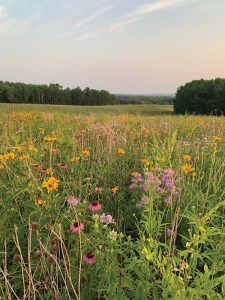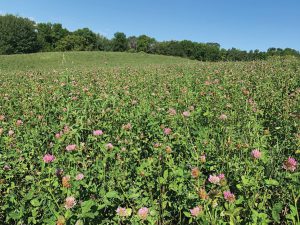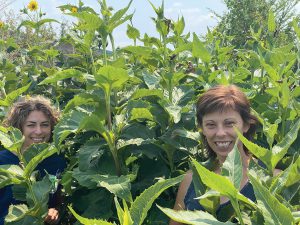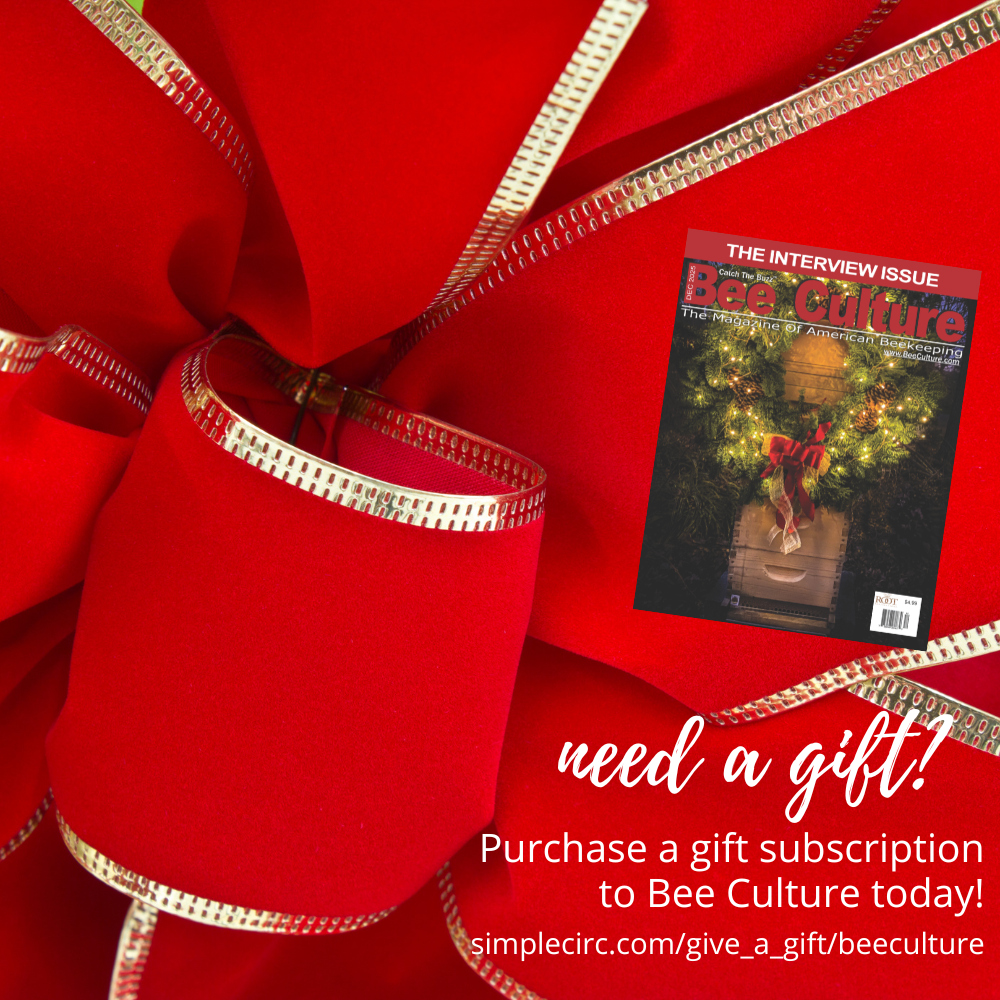Powering Your Bee With Flowers
Becky Masterman & Bridget Mendel
What bees really need are more flowers. Seems easy enough, but like achieving world peace, planting flowers turns out to be complicated, contentious, and very hard to do right on the scale that our bees need.
First, we need to plant the right flowers. But folks disagree on which flowers are the right ones (some people even going so far as to assign moral value – like “good” and “bad” to choice species) to attract the right bees (like it or not, the Battle of the Bees is on, and you can probably guess if honey bees are Davids or Goliaths). And once you figure out what flowers to plant, where to plant them? And are they clean and free of pesticides and other contaminants? Do you have the right cultivars? A long-term maintenance plan? How are you funding your flowers? What programs are there that make it easy for landowners or farmers to initiate or improve pollinator habitat? Let’s just admit it, planting flowers is really complicated.
But if anyone can make headway toward flowers for all bees, we think it’s beekeepers.

Innovative floral seed mix installations like those installed by the Bee and Butterfly Habitat Fund provide season long nectar and pollen for pollinators. Photo credit: Mark Sundberg
We are members of the Minnesota Honey Producers Association (MHPA) with Becky serving as a board member and Bridget as secretary. The MHPA board voted last December 2020 to initiate a Habitat Committee to help its members navigate the broad topic of food (and land!) for their bees. At our 2021 Summer convention, the topic of habitat was woven throughout the three-day program. From identifying areas of concern and habitat successes to discussing native bee health in relation to honey bees, the membership invested time throughout their July weekend to do a deep dive into fields of flowers. We want to report back on this process to you in hopes that you will join us in making habitat a priority for your beekeeping and within your organizations.
Awareness
The first evening of the Minnesota Honey Producers Association meeting is traditionally a chance for members to share how their bees are doing and how much honey they are producing (the evening is affectionately known as the Liars and Braggers’ club). This year, we added a slight twist by asking members to connect bee health and honey production to habitat. The VP of the MHPA shared his observation that where he had added significant flowering habitat–he installed 18 acres in collaboration with the Bee and Butterfly Habitat Fund (https://www.beeandbutterflyfund.org/)–both honey production and colony survivorship increased. Half of the site was planted in a butterfly seed mix and the other half was put into a honey bee seed mix. This is a great example of a beekeeper who supports his honey bees with forage, while also supporting native bees and butterflies. More food for more bees = more more food for bees (and for us). It’s good math.
We discussed the Battle of the Bees – a conflict in which many beekeepers do not even know they are soldiers. If asked, most beekeepers would probably guess they are on the opposite team as the one to which the public has assigned them. While you, dear beekeeper, who shivers with joy at the sight of dozens of absolutely fuzzy bumble bees enjoying the Monarda you planted, may love all bees, others don’t enjoy seeing fuzzy honey bees on clover. Some see beekeepers as the mis-managers of invasive species, bent on a one-bee world. Many native bee scientists and enthusiasts (some of whom are beekeepers) are rightly concerned about honey bees outcompeting native bees for food and about the potential for pathogens to move between different bee species. We need to counter the us vs them narrative by making sure there are diverse flowers, flowers, and more flowers for both our honey bees and our many other native pollinators.
And it’s important for all beekeepers to understand that not all people are honey bee aficionados and to react to concerns about honey bees with a nuanced and thoughtful approach. There are over 4000 native species of bees residing in North America, and monitoring them has become a national concern (Woodard et al. 2020). This concern can translate directly to a problem in sourcing where to set down your colonies. At our honey producers’ meeting, beekeepers described losing bee yards they’d used for decades because of the landowner’s or federal agency’s concern over honey bee-native bee competition.
Details
The last hour of the convention was led by University of Minnesota’s Dr. Marla Spivak. Marla has been a leader in promoting the idea of planting more flowers to support bee health as well as calling attention to issues that could stem from bee competition or pathogen spillover. We spent time identifying state agencies and their efforts to support pollinators. Some state agencies in Minnesota have policies that lean heavily towards supporting native bees, and others are supportive of all bees. Understanding your state agency policies is an opportunity to find partners that will help you increase flowering habitat but will also help you understand the current trends in public concerns over pollinators.
Most importantly, identifying some of the highest return investments for our planting efforts was discussed. Take cover crops, for example. Marla says that they are back in style. Cover crops are hip and they are multi-taskers, particularly if they are flowering covers, like canola, clover and alfalfa. While casually feeding the bees, they also add nitrogen to the soil, prevent soil erosion, sequester carbon, and filter pesticides to protect water.
Spivak reported on an innovative University of Minnesota program called Forever Green that is trying to change agricultural practices to benefit both the farmer and the environment. One project includes pennycress, camelina and canola as winter cover crops that can be harvested for oil. All three can provide an early season nectar flow for bees and other beneficial insects. Part of the challenge is that supply chains for these oilseed crops need to be established, but this work is getting done and beekeepers and their bees might be benefiting from this project soon.
Next Steps
Spivak cautioned that we should not get negative about the threats of native bee competition issues, but instead focus on planting more habitat. Whether you decide to focus on roadsides, cover crops or some other approach to increase the quality and quantity of your bee forage, having a plan is essential. Diverse bee food plantings will diversify our agricultural, suburban, and urban landscapes, which is a win-win. Asking honey bees what flowers they prefer, one study interpreted their waggle dances and found that foragers often flew over diverse native prairie flowers in search of larger floral patches (Carr-Markell 2020). This could be good for the problem of spreading viruses between species: by planting native flowers for native bees, and other areas that specifically benefit honey bees, we may be able to limit some inter-species competition and virus spread . . .

As noted by Marla Spivak, honey bees like to shop for flowers in bulk at wholesale clubs. Large patches of honey bee favorites make it likely that the foragers will return to the hive and recruit their sisters with an enthusiastic waggle dance. Photo credit: Mark Sundberg
If beekeeping organizations across the country make habitat improvement a priority personally, publicly, and politically, the bees will benefit from this collective effort. We beekeepers love the solitary nature of beekeeping, but for this habitat challenge, we’ve gotta go full on superorganism: divvy up tasks, and work together to address the flower shortage with determination and creativity. We will literally increase our honey crops in the end.
References
Carr-Markell MK, Demler CM, Cuvillon MJ, Schurch R, Spivak, M. 2020. Do honey bee (Apis mellifera) foragers recruit their nestmates to native forbs in reconstructed prairie habitats? PlosOne. 15(2): e0228169. https://doi.org/10.1371/ journal.pone.0228169
Woodard,SH, Federman, S, James, RR, Danforth, BN, Griswold,TL, Inouye, D, McFrederick, QS, Morandin, L, Paul, DL, Sellers, E, Strange, JP, Vaughan,M, Williams, NM, Branstetter, MG, Burns, CT, Cane, J, Cariveau, AB, Cariveau, DP, Childers, A, Childers, C, Cox-Foster, DL, Evans, EC, Graham, KK, Hackett, K, Huntzinger, KT, Irwin, RE, Jha, S, Lawson, S, Liang, C, López-Uribe, MM, Melathopoulos, M, Moylett, HMC, Otto, CRV, Ponisio, LC, Richardson, LL, Rose, R, Singh, R, Wehling, W. Towards a U.S. national program for monitoring native bees, Biological Conservation, Volume 252, 2020, 108821, ISSN 0006-3207, https://doi.org/10.1016/j.biocon.2020.108821.
(https://www.sciencedirect.com/science/article/pii/S000632072030879X)
Cover Crops
(https://www.forevergreen.umn.edu/)
https://www.thelandonline.com/news/cover-crops-can-benefit-bees-farmers-bottom-line/article_be4cf79c-eacb-11e4-a0b0-83be98aa4c1b.html
(https://www.iprefercap.org/projects_objectives/supply-chain/)
Acknowledgement
The authors would like to thank Dr. Marla Spivak for helpful edits and suggestions.
 Authors
Authors
Becky Masterman led the UMN Bee Squad from 2013-2019 and currently alternates between acting as an advisor and worker bee for the program. Bridget Mendel joined the Bee Squad in 2013 and has led the program since 2020. Photo of Bridget (left) and Becky (right) pretending to bee habitat.










